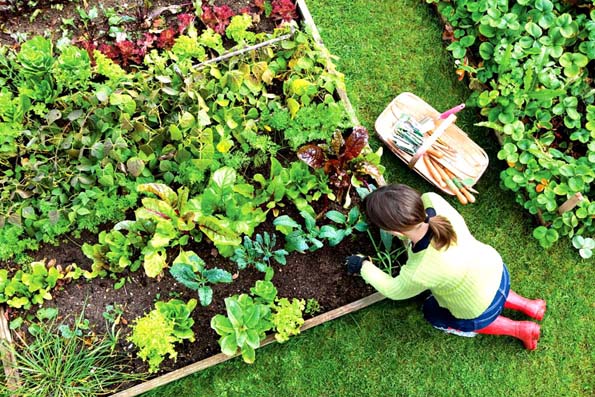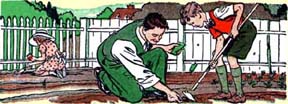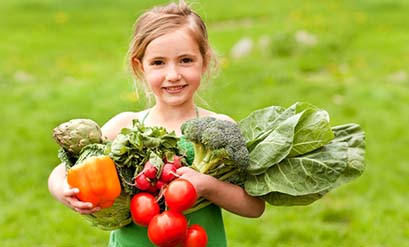
Gardening
for LIFE!
by Mary Louise.Town Jaqua,
Health Minister 4/5/2020
In the spring a young
man's or womans' fancy turns to....gardening!
Yes, it is that time of year to
be thinking about 'getting down to earth'
by planting your own personal garden.
Consider the effort as an
insurance policy for your better health if
not survival. Investing in the
ancient art of gardening pays great dividends
since it feeds both
body and spirit!
While many people are
regular, old time gardeners, those new to
the sport find that, in more ways than one,
gardening is a growing
experience since there is much to learn!
While mistakes can and often
have happy endings, educating one's self
about gardening methods
can make the difference between a bountiful
harvest or a dismal failure.
GARDENING:
Where to start
Education is the best way to start
gardening! Research the vast subject
of gardening by reading books, magazines, or
articles on-line in order
to gain knowledge about growing methods,
especially ones that may
best suit your situation. For added support
search out local farmers and
home gardeners to gain valuable insight
concerning approaches that
work for them and why. Learning from veteran
growers is usually advice
well given and taken plus it's free, so
cultivating friendships with other
garden enthusiasts can pay big dividends.
GARDENING:
Types
Before putting your hands to the
hoe, shovel or plow, and digging into
the soil, consider the all-important strategy
called approach.
There are
many ways to garden but determining the best
approach depends on
one's lifestyle and 'lay of the land.' While
many people have land that
can be easily turned into garden space, some
people do not. Thus
gardening can turn into a creative experience
that defies convention.
This being said, investigate the common
garden types to determine
what approach best suits your lifestyle and
available resources.
Traditional-
a designated garden space in the
yard.The area
should be free of weeds/underbrush,
the soil broken up/tilled,
have good run-off, and have full sun
most of the day.
Raised
beds- sectioned areas that
are raised up from the
ground and therefore easier to work
without strain on knees
and back.
Container
gardens- convenient way to
garden when land space
is not available or preferred.
Favorite planting containers include
ceramic pots, barrels, bags, wooden
boxes, window boxes, old
kitchen pots, etc. Container gardens
can be highly productive,
making them a popular approach to
gardening since containers
can be placed most anywhere where
there is sufficient sun.
Straw
bale gardens- utilizes bales
of straw as a growing
medium instead of soil.
Hydroponic
gardens- growing in water as
opposed to soil.
Vertical
gardens- a space-saving
approach for growing in
small or difficult-to-cultivate areas
Depending on climate
and/or preference, gardening can be done
outdoors, indoors, in greenhouses, and cold
frames. While growing
strategies are seemingly endless, choosing an
approach that is
simple, convenient, and within your budget
delivers the best results
for your efforts.

GARDENING: What to grow
Deciding what to grow is based upon
factors that need to be
considered. Determine what to grow according
to
what you like
to eat
what is easy to
grow
what grows best
in your area
what you can
comfortably fit into your space
Planning a garden
according to these parameters will simplify
your growing experience, making it easier and
ultimately more
productive. While growing vegetable varieties
is most popular,
consider planting herbs, flowers, and fruit
in your garden. After
all, variety is the spice of life!
GARDENING: When
to grow
Generally speaking, it is safe to
start gardening after the danger
of frost has passed. Depending on one's
locale/climate, early
to late May begins the garden season in
northern climes. Check
weather stats for your respective area and
plan your planting
strategy accordingly. Also keep in mind the
ancient science of
planting by moon phases, since some plants
are best planted
in a wanning or a waxing moon. Planting
according to the rhythm
and magnetic pull of the moon proves
historically to increase
productivity.

GARDENING: How to grow
While garden how-to's are countless,
there are basic principles
that, when applied, can ensure a good
harvest. A few good
'rules of (green) thumb' are
use good
soil- the health and quality of
your garden crops
depends upon soil that is rich in
nutrients. Most gardeners
test their soil through state-run
agricultural labs. Lab results
will help determine what, if
anything, should be added to
the soil to make it more
growing-friendly. Avoid using
commercial-type planting soils that
contain questionably-
sourced organic matter and chemicals.
use quality
seeds- organic, heirloom seeds
have better
'growing power,' since they have
retained their DNA
integrity. i.e. have not be
hybridized. Heirloom seed
varieties are thus stronger and more
resilient to disease
which makes them healthier and more
productive.
give plants
space- giving plants plenty of
room to grow
produces a healthier plant and thus a
more productive
harvest. Crowding plants stunts their
growth and can
encourage mold and disease.
use natural
fertilizers- naturally-sourced
and formulated
fertilizers exist which, when
applied, boost production.
One fail-safe fertilizer is manure
from local, organic
farms.
use mulch-
keep your garden moist and at the
same time
discourage weeds by mulching. Mulch
also adds nutrients
to the soil. Popular mulches include
straw, leaves, news-
papers, coconut coir, and more.
compost-
decompose vegetable and fruit scraps
so that
they will turn into super-healthy,
microbe-rich soil. Compost
can be added to the garden before,
during, and after planting.
Making and applying a compost tea as
a natural fertilizer boosts
plant life, but should be used
sparingly since it is very powerful.
use good
tools- a well-designed tool makes
gardening easier,
so consider investing in quality
tools. If the budget does not
exist to purchase expensive tools,
search yard sales and thrift
stores for the tools that you need.
use good
water- be kind to your plants by
watering them with
naturally-sourced water (rain, well,
spring) rather than city
water.
GARDENING:
Protection
Once planted, gardening is
relatively easy. Nevertheless, plants
(like children) need attention as they grow.
Therefore it is wise to
check plants daily to monitor their growth.
In the event that the
plants appear to be endangered, the
problem(s) should be
identified and protective measures taken.
infestations-
insects, bugs, unfriendly worms,
mold, blight,
disease
invaders-
moles, mice, ground hogs, dogs, cats,
predatory
birds, deer, etc.
cold/frost-
sudden temperature dips that can
freeze/kill
plants
Generally speaking,
naturally-sourced solutions solve most
garden problems. Natural insect repellents
exist, home-made or
otherwise. Likewise, invasions by vermin can
be solved by natural
means, including trapping. Protecting plants
from cold can be done
by investing in specially-formulated (but
expensive) row covering
or by using budget-friendly plastic sheeting,
old bedspreads, etc.
Conclusion
Gardening is an adventure that is
both invigorating and rewarding
as it enlivens both body and spirit.
Connecting with the earth and
being part of the growing process is
relaxing, for it fosters a distinct
sense of peace and healing that can only be
experienced up-close-
and-personal. Studies show that
gardening can improve and/or
eliminate bad attitudes, violent behavior,
and more. Thus the benefits
of gardening go beyond the soil and the
harvest in that they can
change lives for the better.
While the advantages of
having a garden are numerous, engaging
in the growing process does require a measure
of commitment,
personal responsibility, and sometimes hard
work. To offset what
some might call the drudgery of gardening,
consider partnering with
family, friends or being part of a community
garden. Many localities
now set aside garden space for residental
use. This option is worth
investigating, especially for first-timers.
No matter what option you
choose, make your gardening experience a fun
one!
Gardening has been part
of the social landscape for thousands of
years. It is woven into the fabric of man's
lifestyle as the foundation
of his well being and survival, especially in
times of hardship. In this
present world of increasing uncertainty,
planting a garden makes good
sense. Having a food source in the backyard,
on the patio, in the house
or wherever could prove to be the best
investment that you ever made.

O taste and
see that YHVH is good: blessed
is the man that trusteth in him.- Psalms
34:8
Beloved, I
wish above all things that thou
mayest prosper and be in health, even as
thy
soul prospereth.- 3 John 1:2
_________________________________________________
Resources:
Garden
Helps-
recommended gardening resources
from the LIVING Way
Johnny's
Selected Seeds
Fedco
Seeds
Seed
Savers
Straw
Bale Gardens
Planting-by-the-moon
Sowing
Seeds: Everything You Need to Know
Gardening on a Budget.
Sprout Gardening
Organic
Gardening with John Kohler
Gardener
Scott
Gardening
advice from GrowVeg
Gardening
with Charles Dowding
Organic
Container Gardening
Grow
salads in plastic bags